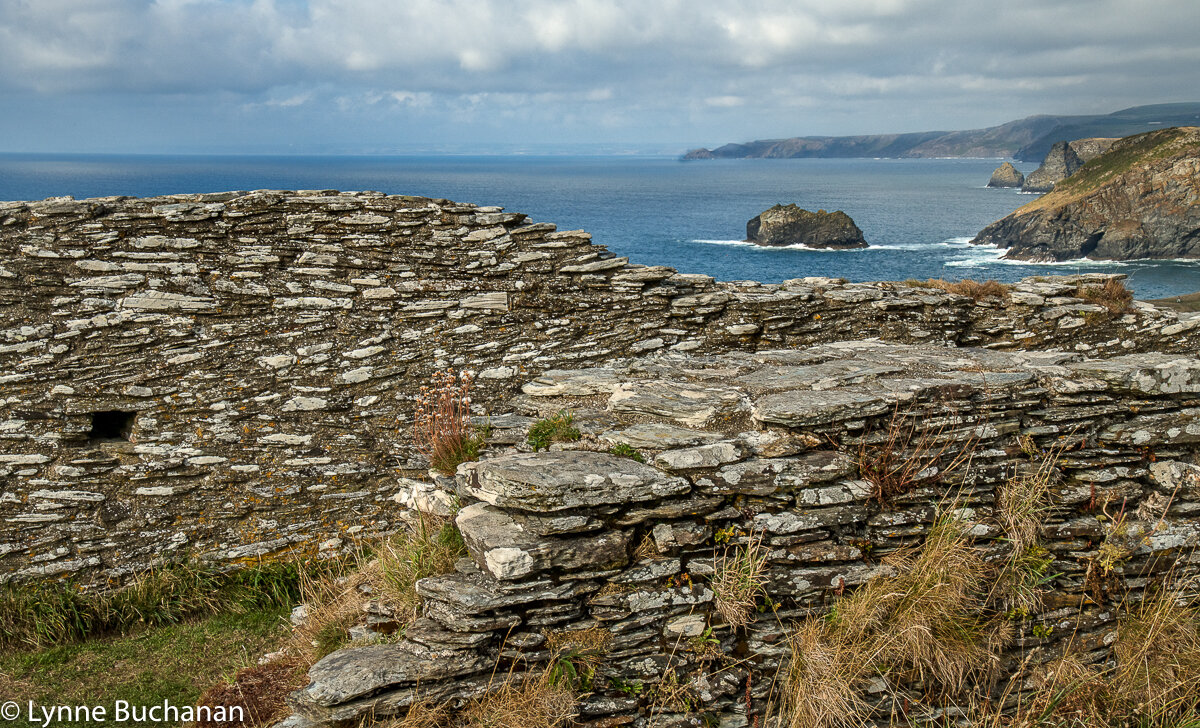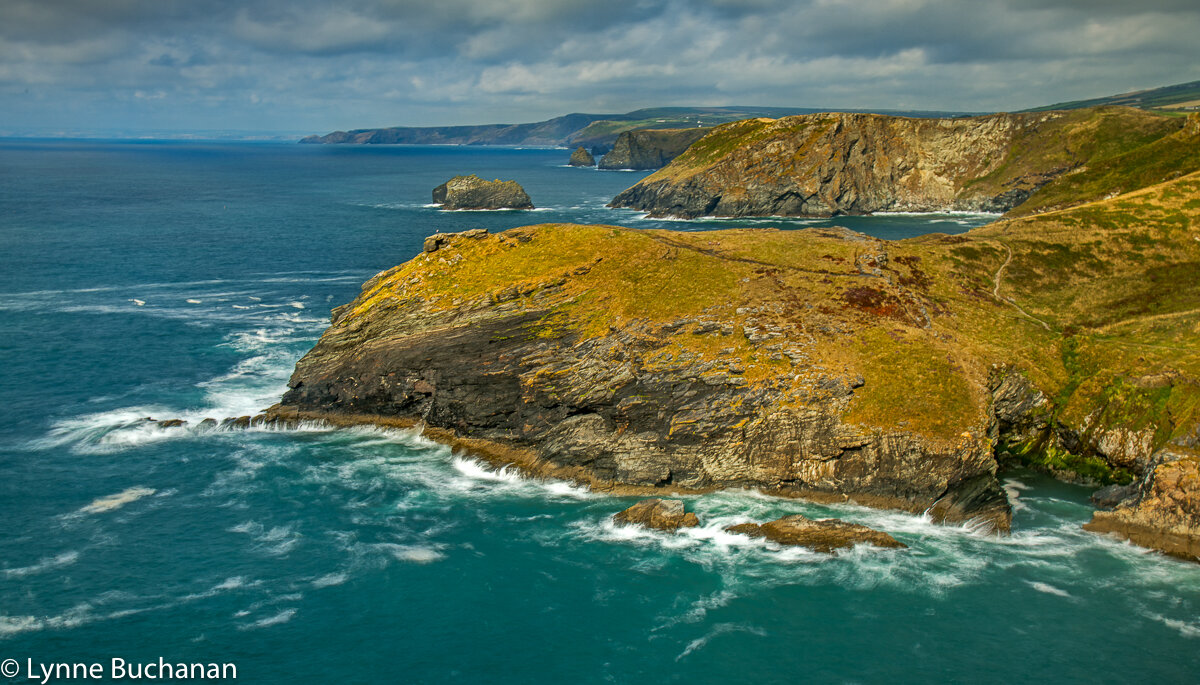Tintagel Coastline and an Historicaly Important Castle in Cornwall
The View from Tintagel Castle
I recently returned from a trip to England, where I was fortunate to be able to visit Cornwall. When I arrived in Bath, everything was browned out and I barely recognized England. My mother is English and I have been there many times and this was the wrost I'd seen it. Things were browned out in Cornwall too in some places, but not as badly as the moisture from the Ocean Breezes kept things more moist. Though plants and trees were suffering in other parts of the country, many English people were delighted to have such good beach weather in their own country though they all seemed to realize it was associated with climate change.
Tintagel Medieval Castle Landing Gate
I hiked down to the end on one side and cape across the old landing gate, which is where people first arrived in the castle. Tintagel was the seat of Cornish Kings from the fifth to the seventh centuries and has been mentioned in conjunction with the legend of King Arthur and the love story of Tristan and Iseult. Its rich history may be why Richard, Earl of Cornwall built this castle in the 1230's (http://www.english-heritage.org.uk/visit/places/tintagel-castle/history-and-legend/).
Cave Across from Tintagle Castle
Merlin's Cave is under the castle, but it is only accessible during low tide. At high tide, the caves all fill with water.
Tintagel Castle Walls
The walls are of course in ruins now, but it is not hard to imagine how it dominated the dramatic coastline with its rocky outcroppings and crashing waves.
View from the Castle Summit
One benefit of the exceptionally warm summer, at least here, was that it turned the water a beautiful turquoise green. The hue is due to the slate and sand in the area's landforms, which also contains traces of copper. When it is warm and the sun's rays reach the water, it accentuates the turquoise and also illuminates the deep blues in the distance that are a result of the water reflecting the sky. Land, earth, and the heavens came together to create a magical tableau made richer by metaphorical fire associated with climate change and warmer temperatures. Though I often like to say that climate change is bad, and I do believe it will cause a myriad of problems for our planet, occasionally it can lead to moments like this where the coast of England suddenly appears more like the Caribbean, at least as far as the water is concerned. I suppose, aside from the loss of species and a proliferation of blue green algae, it will be interesting to see how particular places shift over time. Will British people stop feeling the need to go to the Canary Islands or Florida or other places they frequent to enjoy coastal climates?
Tintagel Castle Ruins on the Rock Jutting out into the Sea
This image was taken from a rock behind the Tintagel Parish Church. I was particularly struck by the biodiversity of the plant life.
Parish Church of St. Materiana, Tintagel
This Norman Church was built between 1080 and 1200 on an earlier burial ground used by the castle's Dark Age occupants. St. Materiana was the patroness of Tintagel and the Patron Saint of Minster. The old lichen covered tombstones that were eroded by the salt air were no longer legible but bore the weight of history nevertheless.
Tintagel Coast Walk Stone Wall with Grasses
From the Bed and Breakfast we stayed in to the Church and Castle there was a coast walk. Old stone walls separated the walk from the fields above and the rocks below. These walls were anything but ordinary stacked in intricate patterns that had a captivating rhythm. The style is actually referred to as the "herringbone pattern, also called ‘Jack and Jill’ or ‘Darby and Joan’" (https://www.conservationhandbooks.com/dry-stone-walling/walls-in-the-landscape/characteristic-regional-walls/). The slate in this area is thinner and more splintery, so this pattery uses stones that otherwise would not be very useful in wall building and creates and stronger structure through the weave.
Tintagel Wall
This close up shows the pattern a little more clearly, and all the lichen growing on the stone.
Tintagel Rocky Coastline with Sea Stack
Sea stacks always fascinate me, the way the forces of water and air and geomorphology leave narrow towers standing that will eventually collapse and become stumps before being completely erased one day.
Tintagel Coast with Sea Stack
The seas were relatively calm on this particular afternoon, so its presence seemed even more unlikely. In a way, it seemed to symbolize the fluke of my own existence, a momentary flash in geological history as I am so insignificant in the context of human history, no matter what good I attempt to do.
Tintagel Cliffs
When you study the cliffs above, you see the layers of slate and understand why the walls demarcating fields were built in the herringbone pattern. The coast path skirts the upper edge of these vertical cliff faces in arcs. What was interesting was in darker crevices ferns and greener vegetation found a way to take purchase amid all the pebbles. This area was known for its quarries.
Wildflowers in Tintagel Hedgerows
Another way of demarcating boundaries besides walls is hedgerows. This one was very striking, with its burst or red-orange flowers in an otherwise solid green expanse..
Rocks Near the Port William Bathed in Evening Light with a Lone Seagull Flying.
For dinner, we went to the Port William Pub that has lovely sea views. As the sun started to set, I had to leave my table indoors and go outside. The light struck the waves crashing the rocks, which were turned a reddish gold from all the reflections in the sky. In the distance, I saw a small seagull flying, which suddenly seemed way more signifiant than it normally would appear because of its position and the light strip of background behind it. That is the magic of life I suppose. It all depends on contrast and positioning and of course light, which has this uncanny ability to both illuminate and elevate the ordinary into something most extraordinary.
Sunset from the Port William Looking Out to Sea
Watching the last rays of the sun depart and the heavens benefit as a result of light refraction and the positioning of our sun,I appreciated how unique this sunset was compared with many I have seen. What I love about these times of day, is that you never know what magic might be in store for you, what slivers of the sky will turn gold or which plants will suddenly seem more colorful than ever before. The magical workings of the universe suddenly come alive. and I always experience a deep sense of gratitude. To become jaded to moments like this is a real tragedy.















